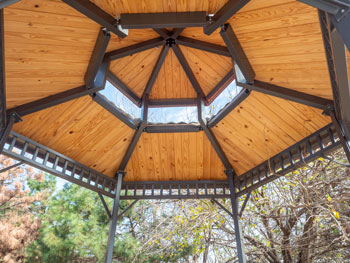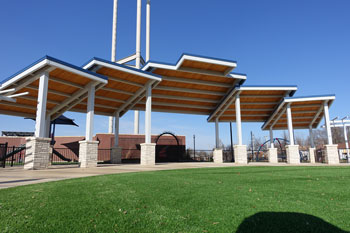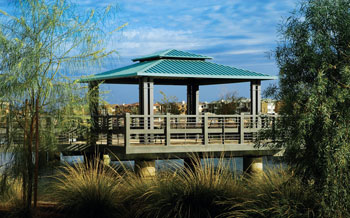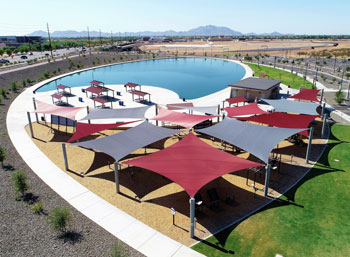Park and recreation facility designers and manufacturers of shade and shelter structures are increasingly being challenged by a demanding public and other municipal stakeholders to not only provide a safe outdoor place under which to protect people from the harmful radiation of the sun and other harsh weather elements —as important as that is—but also to create architecturally sophisticated and visually attractive structures that can function as welcoming social meeting places. If marketed correctly, these structures can also be monetized, thereby providing a return on investment.
“In general terms,” as explained by Kevin Cook, vice president, business development for a Salem, Ill., manufacturer of outdoor elements, “shelters have quickly escalated in importance for parks and recreation directors, facility managers, architects, designers and anyone tasked with creating spaces for people to gather. The options available to park and recreation architectural designers and engineers are unlimited, in terms of colors, material and imagination.”
It wasn’t always this way.

“Today, compared to 10 years ago,” Cook continued, “shelters are seen as a tool, vehicle and platform that provides
gathering spaces for all types of events. After the game celebrations for the local team, engagement and wedding photos, impromptu picnics, club meetings. Meeting spots for weekend bike rides or fun runs. Shelters have become a central part of the function of the community.”
Shelters can be so much more than a place to get out of the sun, run from the rain or eat a hot dog, Cook added. “We have found that many designers, owners or community stakeholders have a vision for a special place. Our job is to ask questions and listen so that the end result achieves the aspiration.”
“Overall, we can provide solutions in many markets,” said Brad Fritz, a sales and marketing manager for a Holland, Mich.-based manufacturer. “But the main use still seems to be providing coverage for people. That might be for someone walking from one location to another and needing safe, well-lit coverage from the elements, or it might be covering vehicles in a parking area or simply creating a nice, sheltered space for a family looking to have lunch.”
Shelters can be cost-effective solutions to a great number of applications.
Design Trends Only Limited by Imagination
Working with Cook is Paul Casey, a project manager. Architects seem to be moving away from the traditional hip roof, gabled roof, gazebo roof, structures and incorporating more modern designs, he said. “Mono-slope designs are big right now. Mid-post cantilever, full cantilever, four-corner-post mono-slope. The shelters are being used as focal points now to draw people in rather than just for protection.”
Another architectural trend, said Fritz’s co-worker, Ben Judy, director of sales and marketing, “is adding accessories to structures such as our new glider. This is something unique that is getting lots of interest due to its quality (bar system instead of chains), limits on motion with stops fore and aft, bench comfort and bearing for improved gliding.”
Charles Saylor, a vice president of a Warren, Mich., manufacturer, has been in the shade and structure business for more than 30 years, and he countered that the classic design of shelters is what most of his clients want and is what his organization specializes in. He does acknowledge that the number of options has increased, “but clients want the tried-and-true basics, which is cost effective.” Some of his standard shapes include squares, hexagonal, octagonal and rectangular open gable or hipped ends.

Since 1987, Saylor said, “we have produced structures using materials such as steel, wood, glass and fabric.”
Like Saylor, Michael Moore, national sales manager for a Dewey, Ariz., manufacturer is seeing a trend toward more traditional models, affordability and structures that the park can utilize every day. “Clients want something solid and durable,” he said.
For him, basic structures haven’t changed much. “The staples that people want are the same: structures that are functional. Ones that the facility doesn’t have to worry about.”
He added that “there is definitely interest by parks and recreation facilities in larger structures, in having that bigger footprint. It’s just a question of whether it is in their budget.”
When it comes to materials, “we are not as diverse as some of our competition that does a lot more wood and gets involved in some of the different materials they do,” Moore said. “We are still family-owned. So, we are staying with steel frames.”
Multi-Use Structures Attract the Public
Park and recreation space stakeholders want a structure that is both practical and eye-catching, said Fritz. Some examples of that, he explained, are walkway covers and entrance canopies to direct visitors where to go through stylish wayfinding and to provide shelter from the elements, connect spaces and enhance surrounding architecture.
Trellises can accent a walkway or seating area and will also fit easily into rooftop gathering spaces, Fritz explained. Other ideas include: adding structures over amusement rides, lines, splash pads and swimming areas; or designing athletic fields with coordinating structures for dugouts, bleacher covers and concession areas.
“Amphitheaters added to create a central gathering space for community events is a popular option,” said Fritz. “And canopy structures can be placed over parking areas or transit facilities.”
Structures over a playground can allow more time outdoors protected from too much direct sunlight. Another use could be to construct a fitness zone promoting a healthy community, and provide a shade cover to protect exercisers from sun exposure. Fabric shade offers limitless possibilities in waterparks, animal exhibits and theme parks.
Stakeholders have become just as creative as designers, as they explain their ideas to the public in community outreach meetings. Go to any local school board or municipal meeting where recreation-related expenditures are discussed, and you’ll find a significant shift from interest in “cookie cutter” shelters to shelters with more sophisticated aesthetics or functionality, Cook said.
Customized structures are “cool,” but all those bells and whistles can be costly, said Moore. “Clients want them but municipalities, we’ve found, are constrained by cost. We try to lead them to some basic structures that are more affordable.”

But even the most basic structures can, with some imagination, have multiple uses and serve the public in several ways. “Since COVID, a lot of events have moved outside, and interest in that continues, even post-pandemic,” Moore said. “Those larger footprints can be used as classrooms or meeting areas.”
There is interest in building larger common areas that are more diverse in what they can do, Moore explained. “You can throw a band underneath it and use it almost like a stage. You can do big meetings. It can be a focal point up front. I get a lot of requests for that, but they are not necessarily our biggest sellers because of budget. You put a cover over a 2,400-square-foot area, the price is pretty large and that is where we get some pushback. Nevertheless, there is interest in that kind of gazebo and shelter.”
Even in these tight economic times, parks and school districts are installing playgrounds and amenities, Moore has found. “That hasn’t stopped. And the shelter, unless it is the main focal point of the whole park, we’ll fall back and use a good, standard design that meets the municipality or district’s budget.
“Every company has their own standards,” Moore said, “but for us the predominant ones don’t have a lot of bells and whistles hanging off of them. Your standard four-six post, roofing, but no ornamentation. Wood is expensive. A lot of people want to see that wood design, and it can be beautiful, but it does add a lot to the bottom-line cost for shelters.
Moore’s company does a lot of greenbelts and parks that are in development. “We’re seeing the effects of the housing market. People are looking for more bang for their bucks,” he added. “If the structure is the focal point of the park, it should also serve a utilitarian purpose.
“The pressure to get people outside into the fresh air, and active has become a staple of a healthy lifestyle, and has helped revive the importance of shelters,” Cook said. “The engineering, design and aesthetic features of shelters have also become a draw to bring people out. Shelters now are planned with integrated seating areas, trash receptacles and even adjacent restroom facilities.”
It is almost as if the idea of putting a shelter in the space defines a commitment to creating the space for people to come together, Cook noted.
Casey, a project manager, delved deeper into the multiple uses possible for structures. “We are currently working on a large project for the southern Indiana city of Washington where the architect has designed the four shelters with these purposes in mind: One shelter will be used as a performance center for plays and musical shows; another will be used as a marketplace for vendors; a third will incorporate walls and be used as a restroom facility; and the fourth as a band shell.”
As a case study of a multi-use structure, Casey pointed to Coxhall Gardens, in Carmel, Ind. The city had a large area designated for children’s play where they wanted to incorporate a picnic shelter with grills. The shelter would be able to be reserved for cookouts and parties, but the area was large so it was suggested that they design two shelters so they could host multiple parties at the same time.

“The idea was well received,” Casey recounted, “but the city was worried that if one large event was reserved there would be a disconnect, so we designed a pathway connecting the shelters covered by a pergola with benches that would invite guests to wander between the two structures. The pergola/pathway could be cordoned off with a chain in the middle for separate events.”
Meanwhile, Kiefer Eller, a colleague of Cook and Casey, is currently doing a design to build a shelter for a pool amenity center. It will have its own bathrooms, two storage rooms and a TV/media area for lounging and eating.
Shelters can also serve as utilitarian canopies for vehicle charging stations, Cook added. “Shelters that incorporate bicycle racks are becoming popular in urban areas,” he added. “We are working on electric vehicle charging station covers. This is new and unorthodox.”
Playgrounds, walkways, picnic areas and gathering areas are standard fare. “We see a lot of demand for big communal structures for smaller towns for multipurpose events.”
Outdoor classrooms were a huge interest at the 2022 NRPA Conference, as well as the American Society for Landscape Architects’ annual conference, Cook observed. “In the last cycle, which was all driven by COVID, we did see increased demand for shelters and different types of site amenities, as school districts were scrambling to create outdoor classrooms.”
Securing Grants and ROI
The pandemic and its aftermath changed everything in how people live and recreate, and because of government programs such as the trillion-dollar Infrastructure Bill and the more recent Build America, Buy America (BABA is part of the Infrastructure Act of 2021), municipalities are able to use grants to fund community improvement projects like recreation spaces and playgrounds.
Custom was king during the pandemic, Moore said, “and there was the feeling on the part of some municipalities that they could do whatever they wanted.”
During COVID, there was a time when money was liquid, through Community Development Block Grants, Moore said, “but I don’t know if that is still the case. The infrastructure BABA grants have also provided some funding for some delayed projects. That money is now hitting the streets. But there are requirements for where the steel comes from, which has to be 100% American-made and can’t come from places like China or Canada. This will be good for municipalities, if they can get their hands on that funding from the government and utilize it for something to build that they haven’t been able to afford to this point.”
As far as earning back your investment in shelters, if you are able to install a larger structure, Moore continued, “it can be rented out, whether on weekends or special occasions. It can be a revenue builder. Even smaller shelters can be reserved and then guaranteed for use as birthday party destinations.”
Cook and Eller shared similar thoughts. A sizable shelter placed in a town square can be used for farmer’s markets, concerts, performances, parties and any event that requires cover from the elements, Eller said. Reserved rental space can apply.
Cook said such spaces can be used for any big gathering. “The key is providing the ability for users to rent/secure the space ahead of time so they can plan, with the assurance that a venue will be available.”
Amphitheaters can be an eye-catching first impression and a central hub within a park for hosting public events, concerts and performances suggested Jennifer Graves, a marketing specialist with a Holland, Mich.-based manufacturer.
“Through ticket admission and fundraisers,” she said, “the amphitheater can be a great resource to bring money back to a community and local charities. Amphitheaters become a focal point within a park and can make it a destination. With the ability to personalize a structure and increase site recognition with laser-cut medallions and signage, or by adding attachment points for temporary banners to identify sponsors and local events, the amphitheater can serve a dual purpose as an advertisement for the park and its event.”
Pavilions at parks, Graves continued, can be rented for events such as birthday parties, receptions and reunions. “Farmers market structures also generate revenue by bringing in rental fees from vendors, which in return also generates money for small local businesses.” RM


